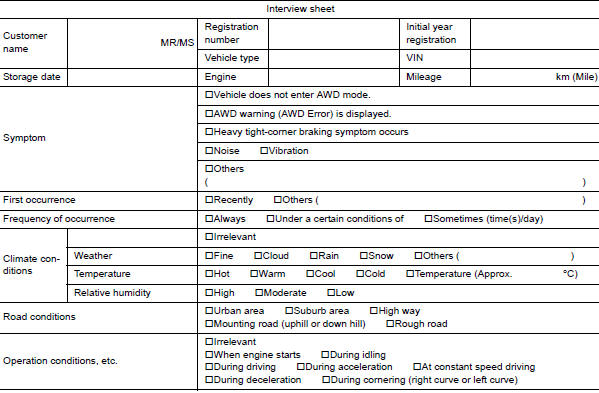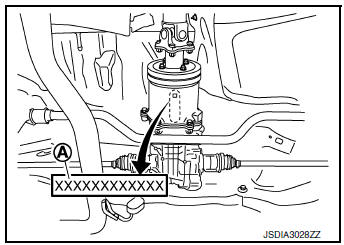Nissan Rogue Service Manual: Basic inspection
DIAGNOSIS AND REPAIR WORK FLOW
Work Flow
DETAILED FLOW
1.INTERVIEW FROM THE CUSTOMER
Clarify customer complaints before inspection. First of all, perform an interview utilizing DLN-32, "Diagnostic Work Sheet" and reproduce symptoms as well as fully understand it. Ask customer about his/her complaints carefully. Check symptoms by driving vehicle with customer, if necessary.
CAUTION: Customers are not professional. Never guess easily like “maybe the customer means that...,” or “maybe the customer mentions this symptom”. >> GO TO 2.
2.CHECK SYMPTOM
Reproduce the symptom that is indicated by the customer, based on the information from the customer obtained by interview. Also check that the symptom is not caused by protection function. Refer to DLN-22, "Protection Function".
CAUTION: When the symptom is caused by normal operation, fully inspect each portion and obtain the understanding of customer that the symptom is not caused by a malfunction.
>> GO TO 3.
3.PERFORM SELF-DIAGNOSIS
 With CONSULT
With CONSULT
Perform self-diagnosis for “ALL MODE AWD/4WD”.
Is any DTC detected? YES >> Record or print self-diagnosis results. GO TO 4.
NO >> GO TO 6.
4.RECHECK SYMPTOM
 With CONSULT
With CONSULT
- Erase self-diagnostic results for “ALL MODE AWD/4WD”.
- Perform DTC confirmation procedures for the error detected system.
NOTE: If some DTCs are detected at the same time, determine the order for performing the diagnosis based on DLN- 22, "DTC Inspection Priority Chart". Is any DTC detected? YES >> GO TO 5.
NO >> Check harness and connectors based on the information obtained by interview. Refer to GI-41, "Intermittent Incident".
5.REPAIR OR REPLACE ERROR-DETECTED PARTS
- Repair or replace error-detected parts.
- Reconnect part or connector after repairing or replacing.
- When DTC is detected, erase self-diagnostic results for “ALL MODE AWD/4WD”.
>> GO TO 7.
6.IDENTIFY ERROR-DETECTED SYSTEM BY SYMPTOM DIAGNOSIS
Estimate error-detected system based on symptom diagnosis and perform inspection.
Can the error-detected system be identified?
YES >> GO TO 7.
NO >> Check harness and connectors based on the information obtained by interview. Refer to GI-41, "Intermittent Incident".
7.FINAL CHECK
 With CONSULT
With CONSULT
- Check the reference value for AWD control module.
- Recheck the symptom and check that symptom is not reproduced on the same conditions.
Is the symptom reproduced? YES >> GO TO 3.
NO >> INSPECTION END
Diagnostic Work Sheet
Description
- In general, customers have their own criteria for a problem. Therefore, it is important to understand the symptom and status well enough by asking the customer about his/her concerns carefully. To systemize all the information for the diagnosis, prepare the interview sheet referring to the interview points.
- In some cases, multiple conditions that appear simultaneously may cause a DTC to be detected.
Interview sheet sample


ADDITIONAL SERVICE WHEN REPLACING AWD CONTROL UNIT
Description
When replacing AWD control unit, unit characteristics writing is required.
Work Procedure
1.PERFORM WRITING UNIT CHARACTERISTICS
Perform writing unit characteristics of electric controlled coupling.
>> Refer to DLN-35, "Work Procedure".
UNIT CHARACTERISTICS WRITING
Description
When replacing AWD control unit, rear final drive assembly and/or electric controlled coupling, unit characteristics of electric controlled coupling writing is required.
Work Procedure
1.UNIT CHARACTERISTICS WRITING
 With CONSULT
With CONSULT
- Confirm the unit characteristics Aof electric controlled coupling.
NOTE: Unit characteristics is 12-digit alphanumeric.
- Turn the ignition switch OFF to ON.
- Select “UNIT CHARACTERISTICS WRITE” in “WORK SUPPORT” for “ALL MODE AWD/4WD”.
- Input unit characteristics.
- Select “Start”.
- Check that “UNIT CHARACTERISTICS WRITE COMPLETED” is displayed.

>> WORK END
 Wiring diagram
Wiring diagram
AWD SYSTEM
Wiring Diagram
...
 DTC/Circuit diagnosis
DTC/Circuit diagnosis
C1201 AWD CONTROL UNIT
DTC Description
DTC DETECTION LOGIC
DTC No.
CONSULT screen terms
(Trouble diagnosis content)
DTC detecting condition
C1201
CONTROLLER FAILURE
( ...
Other materials:
Manual control
While using the Voice Recognition system, it is
possible to select menu options by using the
steering wheel controls instead of speaking voice
commands. To activate manual control mode,
press the PHONE/SEND ( ) button on
the
steering wheel to access the phone menu and
then press either u ...
Servicing air conditioner
The air conditioner system in your NISSAN vehicle
is charged with a refrigerant designed with
the environment in mind.
This refrigerant does not harm the earth’s
ozone layer.
Special charging equipment and lubricant is required
when servicing your NISSAN air conditioner.
Using improper ...
Precaution
Precaution for Supplemental Restraint System (SRS) "AIR BAG" and "SEAT
BELT
PRE-TENSIONER"
The Supplemental Restraint System such as “AIR BAG” and “SEAT BELT PRE-TENSIONER”,
used along
with a front seat belt, helps to reduce the risk or severity of injury to the
...
